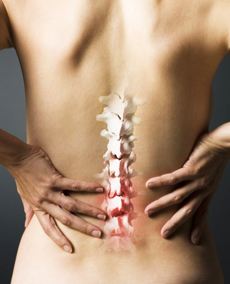|
|
|
 , ,
Font size |
Top 10 to Manage Ankylosing Spondylitis
 Ankylosing
spondylitis occurs predominantly in men (two to three times more common in males
than in females), women can and do develop the disease. Ankylosing
spondylitis occurs predominantly in men (two to three times more common in males
than in females), women can and do develop the disease.
Ankylosing Spondylitis is a systemic auto-immune disorder, becoming apparent in
the form of swelling and irritation in the vertebral joints as well as
stiffness and
pain
in the
back. Some patients may experience only episodes of transient back pain
while some others may experience long standing and severe back pain. If this
problem is not treated properly, it could cause small bony outgrowths from the
edges of the vertebrae. When it involves more than two vertebrae, a person can
become disabled.
Those who have chronic, severe inflammation of the spine can
develop a complete bony fusion of the spine (ankylosis). Once fused,
the pain in the spine disappears, but the affected individual has a
complete loss of spine mobility.
|
The tendency to develop ankylosing spondylitis is believed to be
genetically inherited, and a majority (nearly 90%) of people with ankylosing
spondylitis are born with a gene known as the HLA-B27 gene. Recently, two more
genes have been identified that are associated with ankylosing spondylitis.
These genes are called ARTS1 and IL23R. These genes seem to play a role in
influencing
immune function. Early diagnosis can be difficult but is important; magnetic
resonance imaging of the sacroiliac joints can be helpful in early disease.
Symptoms could be varied ranging from inflammation in the spine, joints and
other organs of the body.
The treatment of ankylosing spondylitis typically involves the use of
medications to reduce inflammation and/or suppress immunity to stop progression
of the disease, physical therapy, and exercise. Physical therapy and exercise
help improve
posture, spine mobility, and lung capacity.
 Use
of (NSAIDs) to Decrease Pain and Stiffness of the Spine and Other joints:
Commonly used NSAIDs include indomethacin (Indocin), tolmetin (Tolectin),
sulindac (Clinoril), naproxen (Naprosyn), and diclofenac (Voltaren). The
decision on which NSAID to use should be on an individual patient basis taking
into account risk factors, particularly for gastrointestinal and
cardiovascular disease. Analgesics, including paracetamol and opioids, may
be considered when NSAIDs are contraindicated or not tolerated. Use
of (NSAIDs) to Decrease Pain and Stiffness of the Spine and Other joints:
Commonly used NSAIDs include indomethacin (Indocin), tolmetin (Tolectin),
sulindac (Clinoril), naproxen (Naprosyn), and diclofenac (Voltaren). The
decision on which NSAID to use should be on an individual patient basis taking
into account risk factors, particularly for gastrointestinal and
cardiovascular disease. Analgesics, including paracetamol and opioids, may
be considered when NSAIDs are contraindicated or not tolerated.

 Maintenance
of Proper Posture: This includes deep breathing for lung expansion and
stretching exercises to improve spine and joint mobility. Since ankylosis of
the spine tends to cause forward curvature, patients are instructed to maintain
erect posture as much as possible and to perform
back-extension exercises. Better
posture makes you feel better in yourself and reduces feelings of self
consciousness. Maintenance
of Proper Posture: This includes deep breathing for lung expansion and
stretching exercises to improve spine and joint mobility. Since ankylosis of
the spine tends to cause forward curvature, patients are instructed to maintain
erect posture as much as possible and to perform
back-extension exercises. Better
posture makes you feel better in yourself and reduces feelings of self
consciousness.
 Sleeping
Posture: Avoid use of pillow and sleep on a firm mattress to prevent spine
curvature. Sleeping on the abdomen (prone) or on the back is better than
sleeping sideways. This helps prevent spinal & hip deformity in the long run. Sleeping
Posture: Avoid use of pillow and sleep on a firm mattress to prevent spine
curvature. Sleeping on the abdomen (prone) or on the back is better than
sleeping sideways. This helps prevent spinal & hip deformity in the long run.
 Exercise: is the single most important thing you can do to help yourself.
The benefits of exercise include increased
flexibility, range of motion, posture and reduced stiffness- the more
flexible you are the easier it is to do everyday tasks such as putting on your
socks or reaching something on a high shelf. Swimming is especially good. Deep
breathing
for several minutes each day will help to keep the joints between your spine
and ribs mobile.
Pilates
has been suggested as a form of exercise to manage ankylosing spondylitis by a
recent
study
" We suggest Pilates exercises as an effective and safe method to improve
physical capacity in AS patients." In order to enhance the muscle power,
several
strengthening exercises (low weights and high repetitions) should be
performed. This would help a person to stay upright as well as erect. Apart from
this, gentle stretching exercises are useful. This would help the person to
prevent stiffness as well as changes in posture. Exercise: is the single most important thing you can do to help yourself.
The benefits of exercise include increased
flexibility, range of motion, posture and reduced stiffness- the more
flexible you are the easier it is to do everyday tasks such as putting on your
socks or reaching something on a high shelf. Swimming is especially good. Deep
breathing
for several minutes each day will help to keep the joints between your spine
and ribs mobile.
Pilates
has been suggested as a form of exercise to manage ankylosing spondylitis by a
recent
study
" We suggest Pilates exercises as an effective and safe method to improve
physical capacity in AS patients." In order to enhance the muscle power,
several
strengthening exercises (low weights and high repetitions) should be
performed. This would help a person to stay upright as well as erect. Apart from
this, gentle stretching exercises are useful. This would help the person to
prevent stiffness as well as changes in posture.

Avoid Wearing a Corset or a Brace: These often make matters worse, as
they hold the spine rigid. Anything that supports the back will allow the
muscles to become weak, and the back will then become more prone to pain and
stiffness. And with ankylosing spondylitis (AS), not moving leads to not being
able to move.


Eat Well: Eat a good nourishing diet with plenty of
proteins. Eat fruit and veggies and also drink milk. Use fat (especially
saturated fat found in animal products), cholesterol, sugar, and salt in
moderation. Drink 8-10 glasses of water a day. Avoid putting on extra
weight.
Extra weight puts additional stress on joints and bones. For example, the
corticosteroid prednisone causes weight gain to some degree in nearly all
patients who take the medication and can lead to redistribution of
body fat
to places like the face, back of the neck, and abdomen.
 Inflammation
and diseases in other organs are to be treated separately: For example,
inflammation of the iris of the eyes (iritis or uveitis) may require cortisone
eyedrops (Pred Forte) and high doses of cortisone by mouth. Additionally,
atropine eyedrops are often given to relax the muscles of the iris. Sometimes
injections of cortisone into the affected eye are necessary when the
inflammation is severe. Heart disease in patients with ankylosing spondylitis,
such as heart block, may require a pacemaker placement or medications for
congestive heart failure. Inflammation
and diseases in other organs are to be treated separately: For example,
inflammation of the iris of the eyes (iritis or uveitis) may require cortisone
eyedrops (Pred Forte) and high doses of cortisone by mouth. Additionally,
atropine eyedrops are often given to relax the muscles of the iris. Sometimes
injections of cortisone into the affected eye are necessary when the
inflammation is severe. Heart disease in patients with ankylosing spondylitis,
such as heart block, may require a pacemaker placement or medications for
congestive heart failure.

Try Heat or Cold: Various forms of heat will help to relieve pain and
stiffness. Hot bath / or shower first thing in the morning and / or before bed
reduces pain and stiffness, especially if some stretching exercises are done at
the same time. Hot weather bottles or electric blankets are quite useful in bed.
For a particularly inflamed area, an ice-pack or bag of frozen peas wrapped in a
damp tea towel may help.
  Lifestyle
Modification is a must for women with ankylosing spondylitis both in their
day-to-day activities and at workplace. For example, workers can adjust
chairs and desks for proper postures. Drivers can use wide rearview mirrors and
prism glasses to compensate for the limited motion in the spine. The ideal chair
at home or at work has a firm seat and an upright, firm back, preferably
extending to the head. The chair should be of a height which will allow you to
keep a right angle with the knee and hip joints. Whatever you do, avoid low,
soft chairs and sofas as they will encourage bad posture and increase pain. Try
not to sit for too long. Stand up, walk about and limber up. Lifestyle
Modification is a must for women with ankylosing spondylitis both in their
day-to-day activities and at workplace. For example, workers can adjust
chairs and desks for proper postures. Drivers can use wide rearview mirrors and
prism glasses to compensate for the limited motion in the spine. The ideal chair
at home or at work has a firm seat and an upright, firm back, preferably
extending to the head. The chair should be of a height which will allow you to
keep a right angle with the knee and hip joints. Whatever you do, avoid low,
soft chairs and sofas as they will encourage bad posture and increase pain. Try
not to sit for too long. Stand up, walk about and limber up.
 Cigarette
Smoking: is strongly discouraged in people with ankylosing spondylitis, as it
can accelerate lung scarring and seriously aggravate breathing difficulties.
Patients with ankylosing spondylitis who currently smoke are likely to be headed
for increased disease activity and worse quality of life outcomes. The results
of a cross-sectional, postal
survey found that, compared with never smoking, current smoking is
associated with higher levels of disease activity, worse functional status,
greater pain and overall poorer quality of life. Cigarette
Smoking: is strongly discouraged in people with ankylosing spondylitis, as it
can accelerate lung scarring and seriously aggravate breathing difficulties.
Patients with ankylosing spondylitis who currently smoke are likely to be headed
for increased disease activity and worse quality of life outcomes. The results
of a cross-sectional, postal
survey found that, compared with never smoking, current smoking is
associated with higher levels of disease activity, worse functional status,
greater pain and overall poorer quality of life.
Pregnancy in women with ankylosing spondylitis does not usually involve any
special problems for mother or baby. However, some medications can be harmful to
unborn children. If you are pregnant or planning to become pregnant, you will
need to discuss the use of medication with your doctor.
Dated 21 February 2012
Related Links
|
|
|
|
|









